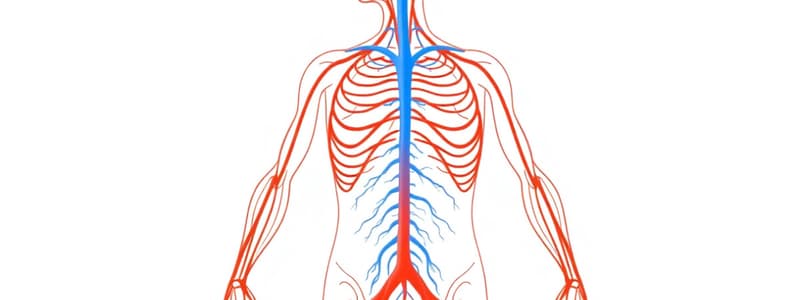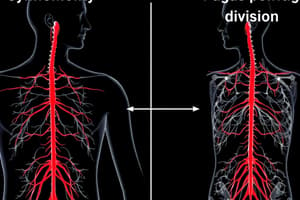Podcast
Questions and Answers
What best describes the term 'anastomoses' in the context of blood circulation?
What best describes the term 'anastomoses' in the context of blood circulation?
- Connections between arteries and veins that facilitate direct blood flow.
- An arrangement of vessels that connects capillaries to veins.
- Connections between arteries that allow for alternative blood flow pathways. (correct)
- Sites where blood vessels branch into smaller vessels.
Which of the following accurately defines blood flow in the circulatory system?
Which of the following accurately defines blood flow in the circulatory system?
- The volume of blood that circulates through the body within a specific time frame. (correct)
- The resistance encountered by blood as it moves through vessels.
- The total amount of blood present in the circulatory system at any given moment.
- The pressure exerted by blood against the vessel walls.
Which of the following factors does NOT affect peripheral resistance?
Which of the following factors does NOT affect peripheral resistance?
- Vessel diameter
- Vessel length
- Blood viscosity
- Heart rate (correct)
What is the primary function of the fibrous pericardium?
What is the primary function of the fibrous pericardium?
What is the primary effect of increased peripheral resistance on blood pressure?
What is the primary effect of increased peripheral resistance on blood pressure?
Which statement accurately describes a difference between atria and ventricles?
Which statement accurately describes a difference between atria and ventricles?
Which statement about anastomoses is true regarding their functional significance?
Which statement about anastomoses is true regarding their functional significance?
Which of the following functions is NOT performed by the atria?
Which of the following functions is NOT performed by the atria?
What structural feature differentiates the left ventricle from the right ventricle?
What structural feature differentiates the left ventricle from the right ventricle?
In terms of function, how do the atria contribute to the cardiac cycle?
In terms of function, how do the atria contribute to the cardiac cycle?
What is the primary method by which carbon dioxide is processed in red blood cells?
What is the primary method by which carbon dioxide is processed in red blood cells?
After carbon dioxide is converted in red blood cells, where is it primarily transported?
After carbon dioxide is converted in red blood cells, where is it primarily transported?
Which statement accurately reflects the transformation of carbon dioxide in the blood?
Which statement accurately reflects the transformation of carbon dioxide in the blood?
Which of the following is NOT a destination for carbon dioxide after its conversion in red blood cells?
Which of the following is NOT a destination for carbon dioxide after its conversion in red blood cells?
Which component is primarily responsible for the conversion of carbon dioxide in red blood cells?
Which component is primarily responsible for the conversion of carbon dioxide in red blood cells?
Which of the following substances is produced by the pancreas?
Which of the following substances is produced by the pancreas?
How do the secretions from the pancreas reach the digestive tract?
How do the secretions from the pancreas reach the digestive tract?
In addition to digestive enzymes, what else does the pancreas produce?
In addition to digestive enzymes, what else does the pancreas produce?
What is the main function of the peritoneal cavity?
What is the main function of the peritoneal cavity?
Which enzyme is NOT produced by the pancreas?
Which enzyme is NOT produced by the pancreas?
What role does the pancreas play in the digestive system?
What role does the pancreas play in the digestive system?
Which of the following correctly describes the mesentery?
Which of the following correctly describes the mesentery?
Which of the following statements about the visceral and parietal peritoneum is accurate?
Which of the following statements about the visceral and parietal peritoneum is accurate?
What distinguishes the two layers of the peritoneum?
What distinguishes the two layers of the peritoneum?
Which statement best describes the role of the peritoneal cavity in digestive function?
Which statement best describes the role of the peritoneal cavity in digestive function?
What is the primary role of bile in digestion?
What is the primary role of bile in digestion?
How does bile travel from the gallbladder to the digestive tract?
How does bile travel from the gallbladder to the digestive tract?
Which organ is responsible for the production of bile?
Which organ is responsible for the production of bile?
What happens to bile when fats are absent in the digestive tract?
What happens to bile when fats are absent in the digestive tract?
What is the relationship between the liver and gallbladder regarding bile?
What is the relationship between the liver and gallbladder regarding bile?
Flashcards
Anastomoses
Anastomoses
Connections between blood vessels that provide alternative routes for blood flow.
Blood flow
Blood flow
Volume of blood flowing through a vessel, tissue, or organ in a given time.
Blood pressure
Blood pressure
Force exerted by blood against the vessel walls.
Peripheral resistance
Peripheral resistance
Signup and view all the flashcards
Factors affecting peripheral resistance
Factors affecting peripheral resistance
Signup and view all the flashcards
Fibrous Pericardium
Fibrous Pericardium
Signup and view all the flashcards
Atria
Atria
Signup and view all the flashcards
Ventricles
Ventricles
Signup and view all the flashcards
Heart Chambers
Heart Chambers
Signup and view all the flashcards
Pericardium Layers
Pericardium Layers
Signup and view all the flashcards
CO2 transport
CO2 transport
Signup and view all the flashcards
Peritoneal cavity
Peritoneal cavity
Signup and view all the flashcards
Bicarbonate ions
Bicarbonate ions
Signup and view all the flashcards
Abdominal organs
Abdominal organs
Signup and view all the flashcards
Visceral peritoneum
Visceral peritoneum
Signup and view all the flashcards
Red blood cells
Red blood cells
Signup and view all the flashcards
Plasma
Plasma
Signup and view all the flashcards
Parietal peritoneum
Parietal peritoneum
Signup and view all the flashcards
Carbon Dioxide (CO2)
Carbon Dioxide (CO2)
Signup and view all the flashcards
Mesentery
Mesentery
Signup and view all the flashcards
Pancreas function
Pancreas function
Signup and view all the flashcards
Pancreas secretions
Pancreas secretions
Signup and view all the flashcards
Digestive enzymes
Digestive enzymes
Signup and view all the flashcards
Digestive hormones
Digestive hormones
Signup and view all the flashcards
Secretion route to digestive tract
Secretion route to digestive tract
Signup and view all the flashcards
Liver function
Liver function
Signup and view all the flashcards
Gallbladder function
Gallbladder function
Signup and view all the flashcards
Bile's role
Bile's role
Signup and view all the flashcards
Bile transport
Bile transport
Signup and view all the flashcards
Bile concentration
Bile concentration
Signup and view all the flashcards
Study Notes
Autonomic Nervous System
- Two main divisions: sympathetic (fight or flight) and parasympathetic (rest and digest)
- Sympathetic originates in the thoracic and lumbar regions of the CNS, uses acetylcholine (preganglionic) and norepinephrine/epinephrine (postganglionic)
- Parasympathetic originates in the brainstem and sacral regions of the CNS, uses acetylcholine (pre- and postganglionic)
- Preganglionic axons are long in the sympathetic division, short in the parasympathetic division
- Postganglionic axons are short in the sympathetic division, long in the parasympathetic division
Anatomical Pathways
- Sympathetic and parasympathetic neurons use preganglionic and postganglionic pathways to reach their target effectors.
Effects on Effectors
- Sympathetic nervous system generally increases heart rate/force and relaxes the bowels.
- Parasympathetic nervous system generally decreases heart rate/force and stimulates the bowels
Adrenal Medulla and Sympathetic Nervous System
- The adrenal medulla is part of the sympathetic nervous system.
- When stimulated, it releases epinephrine and norepinephrine into the bloodstream.
Cholinergic and Adrenergic Receptors
- Cholinergic receptors bind to acetylcholine. Subtypes include muscarinic and nicotinic.
- Adrenergic receptors bind to norepinephrine and epinephrine. Subtypes include α1, α2, β1, β2, and β3.
Dual Innervation
- Many organs receive input from both sympathetic and parasympathetic divisions; this dynamic regulation allows for precise control of bodily functions, such as heart rate.
Endocrine System
- Major function: secreting hormones into the bloodstream to regulate body function.
- Hormone: regulatory substance secreted into the bloodstream
- Endocrine organ: organ that produces hormones (pancreas, anterior pituitary gland, testes, ovary, thyroid, parathyroid, adrenal gland, thymus)
- Target cell: cell with receptors for specific hormones
- Primary endocrine organ: produces or releases primary hormones into the bloodstream
- Secondary endocrine organ: produces hormones, but not its main function
Nervous vs. Endocrine Regulation
- Both systems control body functions; endocrine is slower but longer lasting; nervous is faster but shorter lasting.
Hormone Hyper/Hyposecretion
- Too much or too little hormone production can have detrimental effects.
Chemical Hormone Classes
- Two major classes: amino acid-based and steroid-based.
Cardiovascular System
- The heart is enclosed in the pericardial sac (fibrous and serous pericardium)
- The heart has four chambers (two atria and two ventricles).
- The heart has four valves (tricuspid, mitral, pulmonary, and aortic).
- Coronary arteries supply the heart muscle with oxygenated blood.
Cardiovascular Action Potentials
- Pacemaker cells and contractile cells have unique action potentials that allow for the coordinated contraction and relaxation of the heart.
- The plateau phase in the action potential of contractile cardiac cells is crucial for the long refractory period needed to prevent tetanus-like contractions.
Cardiac Muscle vs Skeletal Muscle Contraction
- Cardiac muscle cells are electrically connected by intercalated discs
- Cardiac myocytes contract in a coordinated manner.
- Skeletal muscle cells are electrically insulated.
- Individual skeletal muscle cells contract independently
Blood
- Plasma: 55% of total blood volume
- Formed elements: red blood cells (erythrocytes), white blood cells (leukocytes), and platelets (thrombocytes).
Blood Cell Types
- Lymphocytes, Monocytes, Eosinophils, Basophils, and Erythrocytes
Anemia Types
- Iron deficiency, pernicious, and hemolytic
Platelets
- Play a vital role in hemostasis.
Lymphatic System
- Lymphatic vessels return lymph to the blood circulation regulation of interstitial fluid volume, absorb dietary fats, and assist in immune function.
- Lymph nodes filter lymph and contain lymphocytes for immune response.
- Spleen filters blood and contains lymphocytes
Immunity (Innate vs Adaptive)
- Innate immunity is present from birth
- Adaptive immunity develops over time
Studying That Suits You
Use AI to generate personalized quizzes and flashcards to suit your learning preferences.




